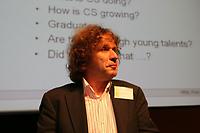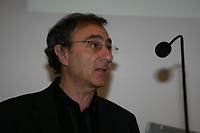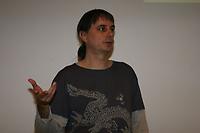Track 6: Medical and Biological Computing
#
Chairperson K.-C. Posch
Slater Mel: Virtual Events Can Evoke Realistic Responses
#
This talk will give a number examples of how virtual reality can evoke realistic responses in people faced with virtual situations and events. Of great importance are interactions between people and virtual humans, where it is shown that people respond realistically to virtual humans even though they are clearly not real beings in any normal sense. Examples will include applications in psychotherapy and social psychology. The talk will conclude with suggestions for future research in this area.
About Mel Slater
His major research interest is the question of what makes virtual reality work, how is it possible to build virtual environments such that people respond realistically to events within them? What scientific explanations are there of this phenomenon? On the other side he also lead research on computer graphics aspects of virtual environments, in particular the issue of real-time global illumination. For this work he was supported by an EPSRC Senior Research Fellowship for 5 years from 1999.
Lobodzinski Suave: Body Signal Computing
#
Recent technological advances in integrated circuits, sensor technology, wireless communications, and embedded physiological signal processing allow for on-the body real-time computing tasks. A seamlessly integrated computing and sensing devices form a Body Signal Computing Network (BSCN), a new enabling technology for in situ body signal computing.
We introduce a wearable multi-sensor, multi-computer system and describe how we optimized our prototype BSCN implementation for computer-assisted real-time cardiac function assessment system. The system performs real-time analysis of sensors' data, provides control signals, generates warnings based on the user's state, level of activity, and environmental conditions. In addition, all recorded information can be transferred to medical servers via the Internet and seamlessly integrated into the user's electronic medical record and research databases.
BSCNs promise inexpensive, unobtrusive, and unsupervised physiological signal processing during normal daily activities for prolonged periods of time. To make this technology practical and affordable, a number of challenging issues should be resolved, such as system design, configuration and customization, seamless integration, standardization, further utilization of common off-the-shelf components, security and privacy, and social issues.
About Suave Lobodzinski
Professional Experience: Full Professor, California State University - Biomedical Engineering Full Professor, University of California Los Angles (UCLA) - Cardiology Department
Schreier Günter: keep in TOUCH - Therapy Optimisation Using Computerized Healthmonitoring
#
A number of multiplying factors (demographics, lifestyle, and better acute treatment) leads to an ever increasing chronic disease burden in the developed countries. Since we do not have enough resources to deal with this using the conventional approaches of the past, we have to leverage information and communication technology as much as possible. Crucial elements of future eHealth systems will be mobile phone based healthmonitoring, automated feedback to patients and decision support for physicians. These concepts provide for new and automated links between patients and doctors so as to facilitate advanced healthcare that extends beyond current borders in terms of space, time and knowledge.
About Günter Schreier
Following positions in research and industry, he currently is the head of the eHealth systems department of the biomedical engineering division of the Austrian Research Centers GmbH - ARC and leads research teams in Graz, Hall in Tirol and Vienna.
Dr. Schreier is a Distinquished Lecturer at the Graz University of Technology and a lecturer at the University of Applied Sciences FH JOANNEUM in Graz. His areas of expertise and research interests are in biomedical informatics, telemedicine and eHealth.
He has authored or co-authored more than 250 scientific publications and presentations and received a number of research awards and prices, among those first places in the 'Computers in Cardiology Challenges' 2001, 2004 and 2006, respectively and the ARC Award in the category of Science in 2002.
Dr. Schreier is a member of the Board of the Austrian Society of Biomedical Engineering, the head of the working group 'medical informatics and eHealth' of the Austrian Computer Society, a member of the Board of the Austrian Scientific Society for Telemedicine and eHealth and a Member of the IEEE Engineering in Medicine and Biology Society.
Edelsbrunner Herbert: Measuring Periodicity in Gene Expression with Persistence
#
The work presented in this talk is motivated by microarray experiments aimed at illuminating gene regulation in embryonic somite development. This development is approximately periodic, generating one somite at a time. The microarray experiment yields a one-dimensional function representing expression per gene. We measure the extent to which a function follows the same periodic pattern and is a candidate in participating in the process. To this end we simplify functions, integrate numbers of critical points, and prove the stability of the resulting measure. We evaluate the resulting rankings based on genes for which there is biological evidence of their direct involvement in somite development.
The microarray work is due to Olivier Pourquie and Mary-Lee Dequeant. The assessment of periodicity of the expressions of few thousand gene is done in collaboriation with Yuriy Mileyko.
About Herbert Edelsbrunner
In the meantime he also started a company together with his wife, the " Raindrop Geomagic" and was Visiting Professor at the Hong Kong University of Science and Technology.
From 2000 to 2006, he worked on an NSF funded ITR project on bio-geometry, short for "computational geometry for structural biology and bioinformatics". In the year 2005, he started two DARPA funded projects. The first is on tda, short for "algebraic topological tools for high dimensional data analysis and the study of families of shapes". Under its umbrella we develop algorithms for homology groups, persistence, Morse complexes and more. The second is on funbio, short for "microstates to macrodynamics: a new mathematics of biology". It aims at deepening the understanding of broad biological questions through the use of novel mathematical methods. Data analysis with algebraic topology is one of the new methods.
Continue to Track 7




